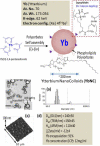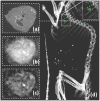An early investigation of ytterbium nanocolloids for selective and quantitative "multicolor" spectral CT imaging
- PMID: 22385324
- PMCID: PMC3529639
- DOI: 10.1021/nn300392x
An early investigation of ytterbium nanocolloids for selective and quantitative "multicolor" spectral CT imaging
Abstract
We report a novel molecular imaging agent based on ytterbium designed for use with spectral "multicolor" computed tomography (CT). Spectral CT or multicolored CT provides all of the benefits of traditional CT, such as rapid tomographic X-ray imaging, but in addition, it simultaneously discriminates metal-rich contrast agents based on the element's unique X-ray K-edge energy signature. Our synthetic approach involved the use of organically soluble Yb(III) complex to produce nanocolloids of Yb of noncrystalline nature incorporating a high density of Yb (>500K/nanoparticle) into a stable metal particle. The resultant particles are constrained to vasculature (∼200 nm) and are highly selective for binding fibrin in the ruptured atherosclerotic plaque. Nanoparticles exhibited excellent signal sensitivity, and the spectral CT technique uniquely discriminates the K-edge signal (60 keV) of Yb from calcium (bones). Bioelimination and preliminary biodistribution reflected the overall safety and defined clearance of these particles in a rodent model.
Figures




Similar articles
-
Recent advances in ytterbium-based contrast agents for in vivo X-ray computed tomography imaging: promises and prospects.Contrast Media Mol Imaging. 2014 Jan-Feb;9(1):26-36. doi: 10.1002/cmmi.1537. Contrast Media Mol Imaging. 2014. PMID: 24470292 Review.
-
Yb³⁺/Er³⁺-Codoped Bi₂O₃ Nanospheres: Probe for Upconversion Luminescence Imaging and Binary Contrast Agent for Computed Tomography Imaging.ACS Appl Mater Interfaces. 2015 Dec 2;7(47):26346-54. doi: 10.1021/acsami.5b09990. Epub 2015 Nov 19. ACS Appl Mater Interfaces. 2015. PMID: 26561383
-
Multicolor computed tomographic molecular imaging with noncrystalline high-metal-density nanobeacons.Contrast Media Mol Imaging. 2014 Jan-Feb;9(1):13-25. doi: 10.1002/cmmi.1571. Contrast Media Mol Imaging. 2014. PMID: 24470291 Free PMC article. Review.
-
Long-circulating Er3+-doped Yb2O3 up-conversion nanoparticle as an in vivo X-Ray CT imaging contrast agent.Biomaterials. 2012 Oct;33(28):6748-57. doi: 10.1016/j.biomaterials.2012.06.033. Epub 2012 Jul 6. Biomaterials. 2012. PMID: 22770569
-
PEGylated hybrid ytterbia nanoparticles as high-performance diagnostic probes for in vivo magnetic resonance and X-ray computed tomography imaging with low systemic toxicity.Nanoscale. 2013 May 21;5(10):4252-61. doi: 10.1039/c3nr00491k. Nanoscale. 2013. PMID: 23546530
Cited by
-
Multifunctional gold nanoparticles for diagnosis and therapy of disease.Mol Pharm. 2013 Mar 4;10(3):831-47. doi: 10.1021/mp3005885. Epub 2013 Feb 11. Mol Pharm. 2013. PMID: 23360440 Free PMC article. Review.
-
Opportunities for new CT contrast agents to maximize the diagnostic potential of emerging spectral CT technologies.Adv Drug Deliv Rev. 2017 Apr;113:201-222. doi: 10.1016/j.addr.2016.09.001. Epub 2016 Sep 9. Adv Drug Deliv Rev. 2017. PMID: 27620496 Free PMC article. Review.
-
Assessment of candidate elements for development of spectral photon-counting CT specific contrast agents.Sci Rep. 2018 Aug 14;8(1):12119. doi: 10.1038/s41598-018-30570-y. Sci Rep. 2018. PMID: 30108247 Free PMC article.
-
Poly(iohexol) nanoparticles as contrast agents for in vivo X-ray computed tomography imaging.J Am Chem Soc. 2013 Sep 18;135(37):13620-3. doi: 10.1021/ja405196f. Epub 2013 Sep 4. J Am Chem Soc. 2013. PMID: 23987119 Free PMC article.
-
Multicolor spectral photon-counting computed tomography: in vivo dual contrast imaging with a high count rate scanner.Sci Rep. 2017 Jul 6;7(1):4784. doi: 10.1038/s41598-017-04659-9. Sci Rep. 2017. PMID: 28684756 Free PMC article.
References
-
- Benson R. The Present Status of Coronary Arterial Disease. Arch Pathol Lab Med. 1926;2:876–916.
-
- Constantinides P. Plaque Fissures In Human Coronary Thrombosis. JAtheroscler Res. 1966;6:1–17.
-
- Kelly JL, Thickman D, Abramson SD, Chen PR, Smazal SF, Fleishman MJ, Lingam SC. Coronary CT Angiography Findings In Patients Without Coronary Calcification. AJR Am. J. Roentgenol. 2008;191:50–55. - PubMed
-
- Tong LL. Poor Correlation Between Coronary Artery Calcification and Obstructive Coronary Artery Disease In An End-Stage Renal Disease Patient. Hemodial. Int. 2008;12:16–22. - PubMed
-
- Taylor AJ. A Comparison of the Framingham Risk Index, Coronary Artery Calcification, and Culprit Plaque Morphology in Sudden Cardiac Death. Circulation. 2000;101:1243–1248. - PubMed

